“Etsy support services are not responsive, so I have given up on asking them questions,” shared one frustrated Reddit user while trying to sync Shopify and Etsy.
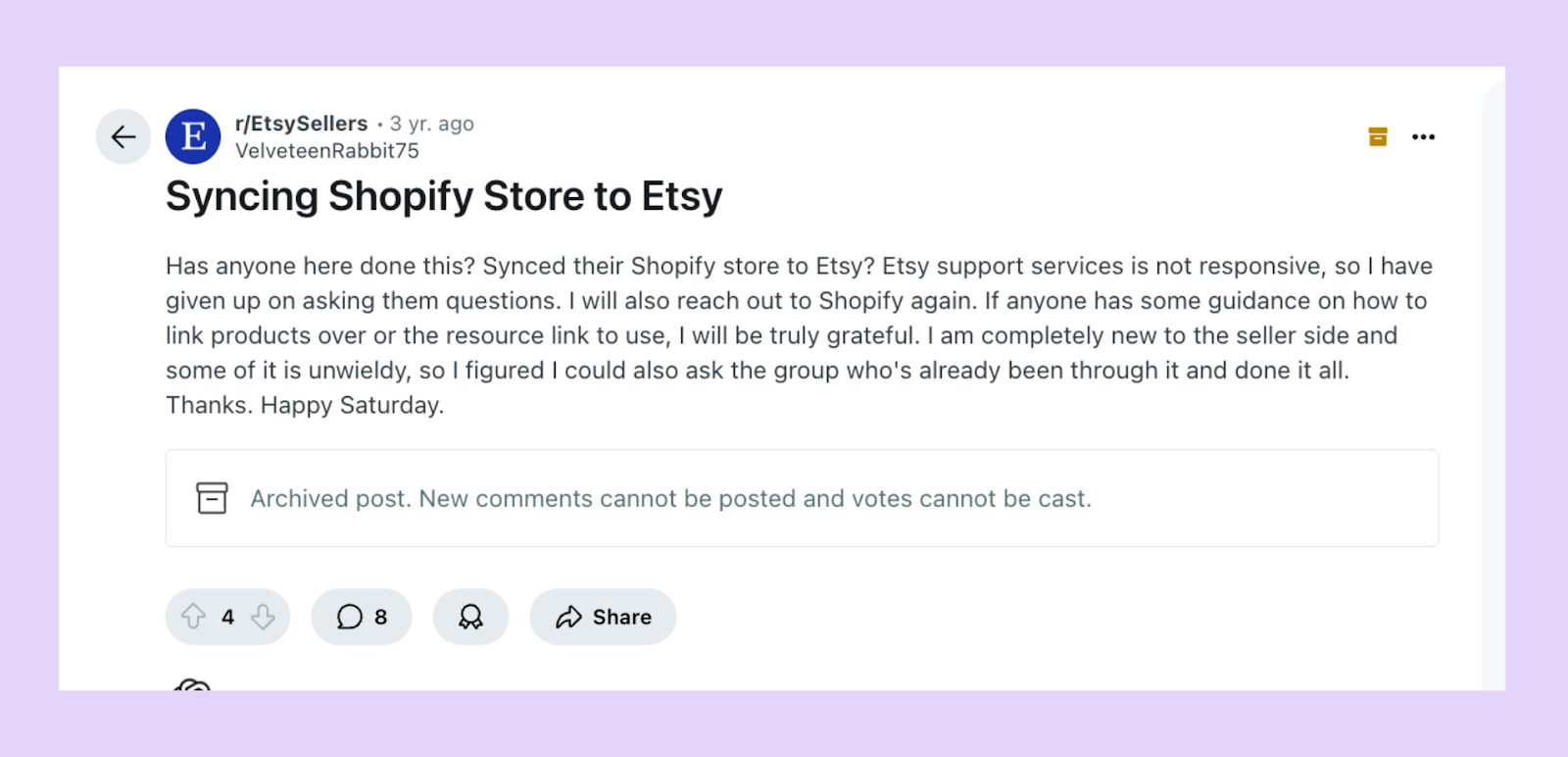
If you’re in the same boat, struggling to connect two platforms, running into errors, and not finding clear answers, you’re not alone.
We walk you through different ways to sync Shopify and Etsy inventory, highlight the most common issues, and share practical solutions to get your inventory running smoothly.
Why Should You Sync Shopify and Etsy Inventory
When Shopify and Etsy are not connected, inventory problems stack up. You sell something in one store, the other store still shows it as in stock, and before you know it, you’ve sold the same item twice.
Synced inventory gives you a single source of truth. That means Shopify and Etsy pull from the same stock numbers, no matter where the order comes in.
There’s no version A and version B of your inventory. Just one version that’s always accurate.
However, both platforms handle stock differently, which is where the real challenges begin.
- On-hand vs available inventory: On-hand is everything in your warehouse, while available is what’s left after open orders are deducted. Shopify might adjust based on pre-orders instantly, while Etsy may not. Without syncing, they fall out of step quickly.
- Timing: Let’s say you only have two units left. A customer buys one on Etsy, and someone else checks out on Shopify two minutes later. If sync lags even slightly, you just sold more than you have. That’s why sync speed also matters. Inventory has to update the second an order comes in.
There are several ways to sync Shopify and Etsy inventory, and here are the most effective ones.
1. Using Shopify Marketplace Connect
Shopify Marketplace Connect is Shopify’s built-in app for linking with marketplaces like Etsy, Amazon, and Walmart. It syncs product listings, inventory, and orders directly from your Shopify dashboard.
Here’s how it works
- Pushes Shopify listings to Etsy without recreating them manually
- Keeps inventory in sync both ways; Etsy sales reduce Shopify stock and vice versa
- Pulls Etsy orders into Shopify, so you can fulfill everything from one place
With Shopify Marketplace Connect, you manage listings, inventory, and orders in Shopify itself. No extra tools, no switching tabs; just one dashboard to keep everything aligned.
2. Sync with third-party apps
For stores that need real-time inventory sync between Shopify and Etsy, third-party tools such as CED Commerce and Sellbrite cover what native apps often miss.
Acting as a connector, they automate stock updates, listing sync, and order routing across platforms.
They’re especially valuable when
- You need instant stock adjustments after every order
- You sell bundles, kits, or manage multi-location inventory
- You want deeper control over how product data maps across channels
Shopify’s built-in tools cover basics, but for advanced inventory logic and true multi-channel control, third-party apps are the better choice.
3. Custom sync with the Etsy API
Building a custom sync with the Etsy API gives you complete control over how inventory updates flow between Shopify and Etsy. You decide when stock changes, what gets pushed, and how products are mapped across platforms.
To do this, you’ll need a developer skilled in Etsy’s REST API and Shopify’s Admin API. That means setting up authentication, managing rate limits, and coding logic for order sync, inventory updates, and listing management.
This route makes sense if you have custom fulfillment rules, non-standard SKUs, or workflows that off-the-shelf tools can’t support. It’s also a strong fit for teams already running in-house systems and wanting everything under one roof.
But keep in mind: it’s an expensive option that requires ongoing maintenance. Every API change or new use case means more development work, so costs and upkeep can add up quickly.
How to Sync Inventory Between Etsy and Shopify Automatically
Create a single source of truth across Etsy and Shopify by following these steps, and automate your inventory sync in real time.
Step 1: Clean up product data
Syncing only works when product data is consistent across Shopify and Etsy.
The first step is to review SKU hygiene. Every product and variant needs a unique SKU, leaving fields blank or using duplicates makes it impossible for systems to know what to update. SKUs must also match across both platforms to ensure accurate syncing.
Next, focus on variant mapping. Shopify SKUs are recorded with structured attributes like size and color, while Etsy flattens these options. If naming or formatting isn’t consistent, inventory won’t map correctly, leading to missing stock or duplicate listings.
Before you start syncing, make sure
- SKUs are unique across the entire catalog
- Variant names and option values match on both platforms
- Draft or archived products that are no longer active are cleared out
Step 2: Connect and map listings
After cleaning your product data, the next step is to connect Shopify and Etsy by linking each listing to the correct product. SKUs must match; otherwise, you’ll need to relabel or manually map items.
Then, set inventory update rules: decide whether Shopify acts as the single source of truth or if stock updates should flow in both directions.
Finally, confirm attribute mapping. Proper mapping ensures stock levels are reduced accurately on both platforms with every order.
Step 3: Test orders and stock decrements
After connecting your listings, it’s essential to test how orders impact stock. Place a sample order on Shopify and confirm the inventory count decreases on Etsy. Then repeat the process in reverse. Create an Etsy order and check that Shopify updates correctly.
As part of testing, measure sync speed as well. Even a short delay can trigger overselling when stock is low. Verifying both accuracy and speed ensures inventory decrements are consistent across platforms and reliable in real-world conditions.
Advanced Scenarios in Shopify and Etsy Inventory Sync
Beyond basics, inventory sync gets more complex when you’re dealing with bundles, multi-location stock, or custom fulfillment rules.
These advanced scenarios require smarter workflows to keep Shopify and Etsy aligned.
1. Managing bundles and kits
Bundles and kits complicate inventory sync because one order must adjust stock for several products at once. If the logic isn’t handled correctly, Shopify and Etsy show inconsistent counts.
Most native tools don’t support bundle logic, leaving you with error-prone manual updates.
Prediko solves this by applying bundle math automatically. Every time a bundle sells, it deducts the right quantity from each connected SKU in real time, keeping Shopify and Etsy perfectly aligned without the extra work.
2. Handling made-to-order and preorders
When syncing Shopify and Etsy, preorders and made-to-order products need to be treated differently. On Shopify, you can list items as preorders with clear fulfillment timelines (for example, shipping in two weeks).
On Etsy, preorders aren’t allowed, so the same products must be listed as “made to order” with accurate processing and shipping times.
To keep both platforms aligned, connect them to the same production capacity pool.
Every order, whether it’s a preorder from Shopify or a made-to-order sale from Etsy, reduces that shared pool, so that you don’t oversell and delivery timelines stay accurate across both channels.
3. Multi-warehouse sync
When inventory is spread across multiple warehouses, syncing Shopify and Etsy becomes more complex.
Stock must be allocated per channel so that each platform shows the right availability. If the same units are exposed to both stores, overselling becomes a real risk.
This is especially critical during Etsy drops, where sudden demand can wipe out inventory in minutes. Without warehouse-level rules, a surge of Etsy orders can consume stock intended for Shopify or the other way around.
The fix is to set clear allocation rules and ensure your sync reflects warehouse-level availability, not just total stock.
Troubleshooting Common Issues When You Sync Shopify and Etsy Inventory
Even with clean product data and the right tools, sync issues can still happen. Here are the most common ones and how to fix them.
Issue 1: Listings may deactivate
Etsy listing deactivation is a big problem. Big enough for there to be an entire Reddit thread about it.
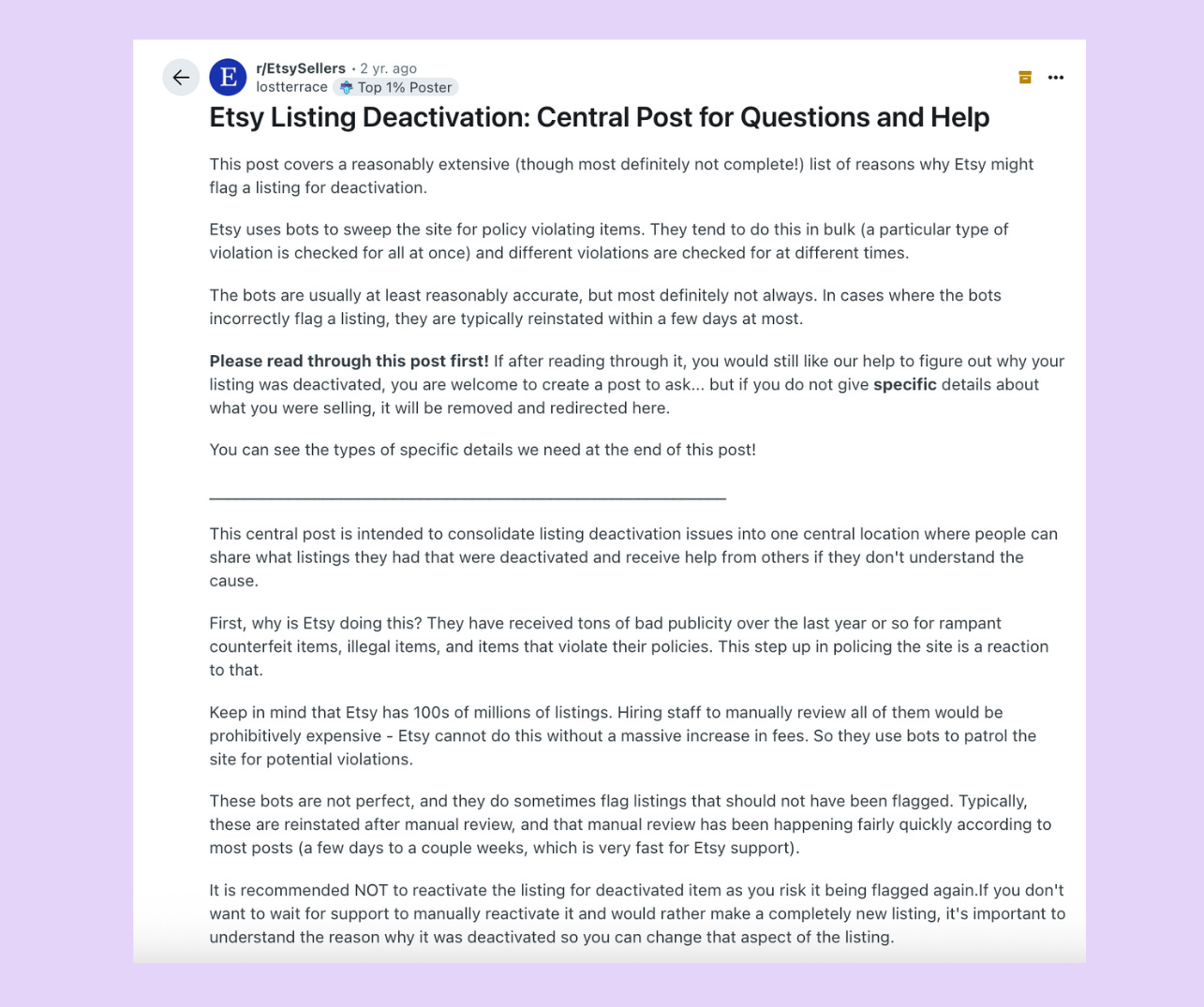
Etsy can deactivate listings when stock reaches zero or when product data doesn’t meet Etsy’s requirements. This often happens if Shopify deducts stock before Etsy updates or if attributes like tags, categories, or variations are missing.
Solution
Start by reviewing deactivated listings to confirm the cause. If stock is still available in Shopify, republish the listing or trigger a manual sync.
To prevent future deactivations, maintain a small safety stock on Etsy, and ensure all required fields (titles, descriptions, tags, and categories) are correctly mapped before syncing. Double-check that your listings comply with Etsy’s rules to keep them active.
Issue 2: Dealing with latency or missed updates
Etsy applies strict API limits, which means most sync tools process updates in batches rather than instantly.
If an order comes in during this lag, Shopify and Etsy can end up showing different stock counts, leading to overselling or inaccurate availability.
Solution
Test your integration’s average sync speed by placing test orders on both platforms and monitoring how quickly stock levels adjust.
If you notice frequent delays, adjust your sync settings to prioritize faster inventory updates or shorten the update intervals.
Issue 3: Fixing SKU mismatches
Syncing only works when SKUs match across both platforms.
If a product in Shopify doesn’t share the same SKU as its Etsy listing, the systems can’t align inventory.
This issue is especially common with older Etsy listings where SKUs were left blank or added inconsistently, causing updates to fail or duplicate products to appear.
Solution
Audit your catalogs on both Shopify and Etsy to confirm that every product and variant has a unique, matching SKU.
Fill in any missing values and correct duplicates directly in each platform before reconnecting. Once SKUs are standardized, your sync tool can accurately update stock levels across both channels.
Prediko’s Role in Shopify and Etsy Inventory Sync
Once your Shopify and Etsy stores are connected, Prediko becomes single source of truth for your inventory.
Instead of juggling spreadsheets, manual updates, or clunky third-party sync tools, everything related to inventory is centralized, from planning and purchasing to restocking and raw materials.
Its key features include
- Accurate stock visibility: Get real-time visibility of inventory across Shopify and Etsy. Every stock movement is tracked, so you always know exactly how much is available and where.
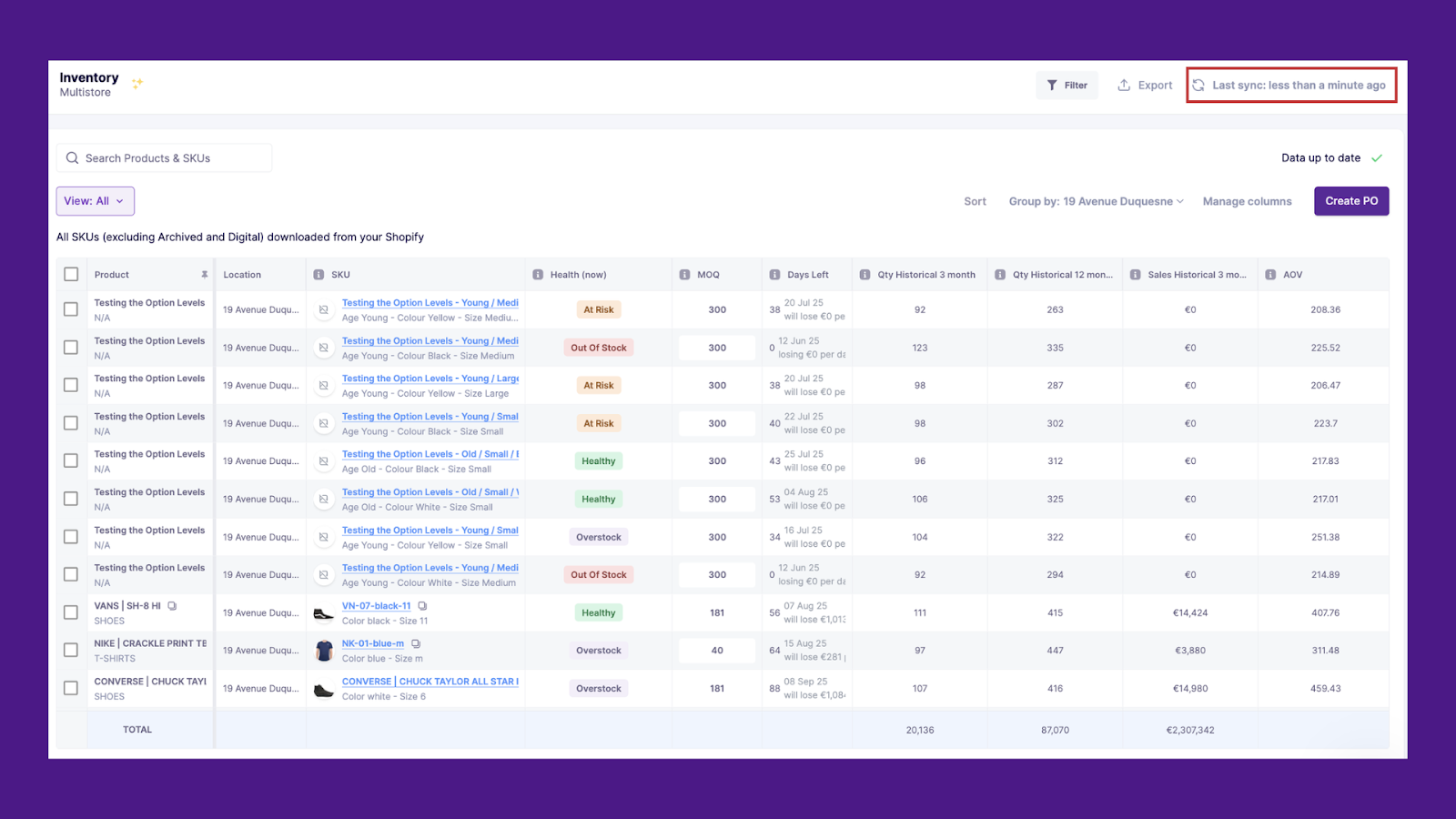
- Multi-channel demand forecasting: Prediko’s AI combines Shopify and Etsy sales data to predict demand, enabling informed purchasing and material planning. Drill down by channel for added granularity.
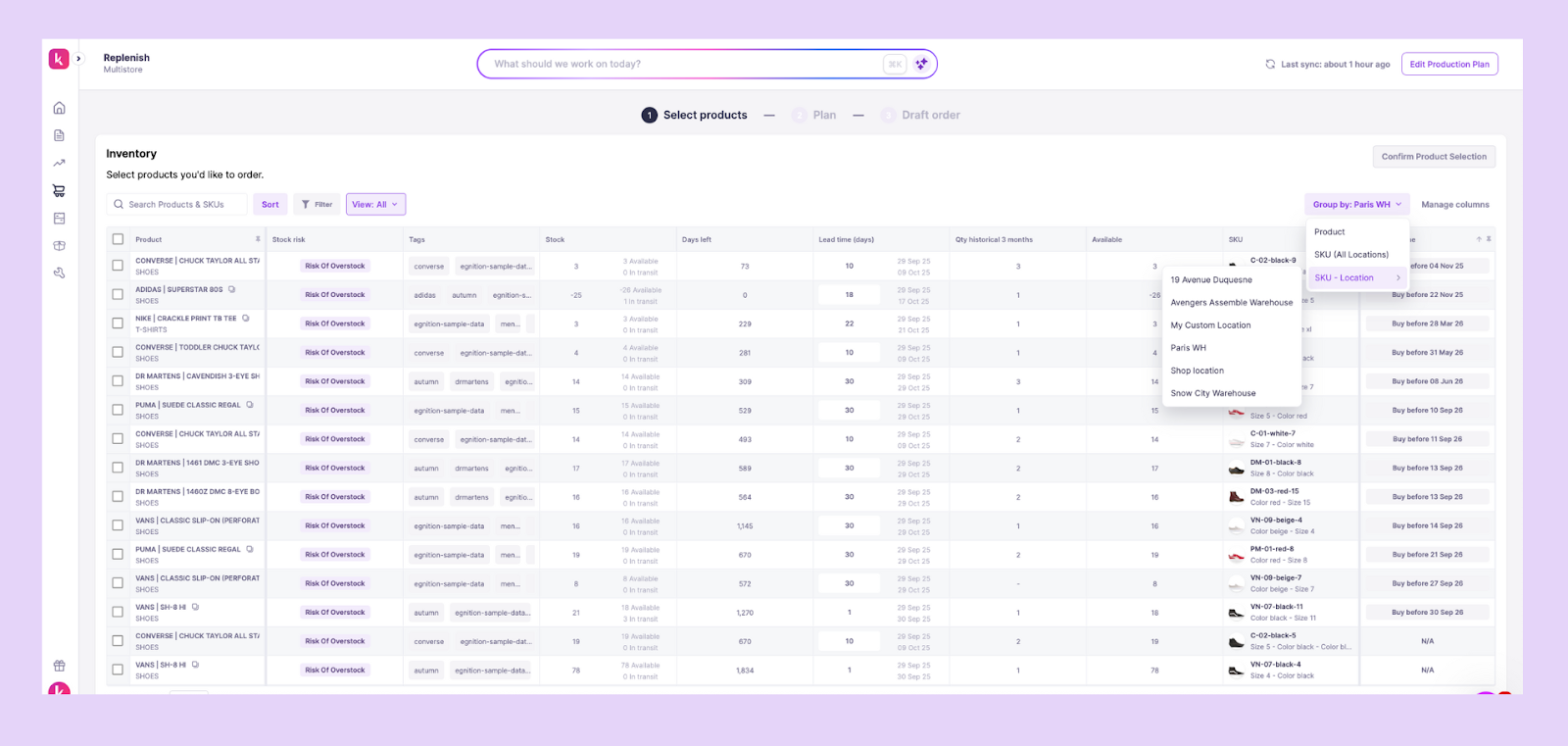
- Smarter purchasing decisions: Prediko generates AI-driven buying plans that consolidate demand from Shopify and Etsy. You can also access location/channel-wise purchase plans, preventing overstocks and stockouts.

- Centralized analytics: With Prediko, you get Reports covering sell-through rate, turnover, and stock health across both platforms. Instead of juggling Etsy & Shopify dashboards, you get one source of truth.
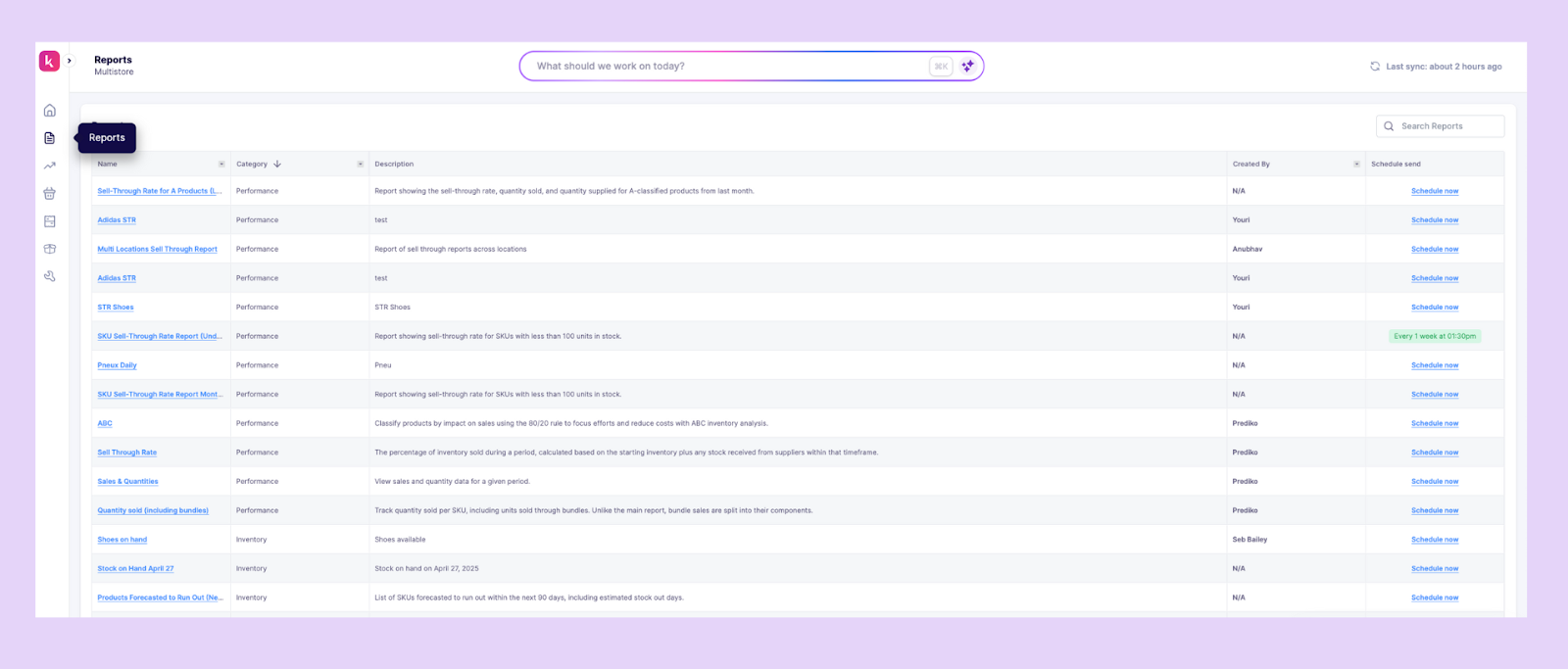
- Purchase Order management: Prediko creates purchase orders factoring in Shopify and Etsy demand, tracking supplier lead times and delivery dates in one system.
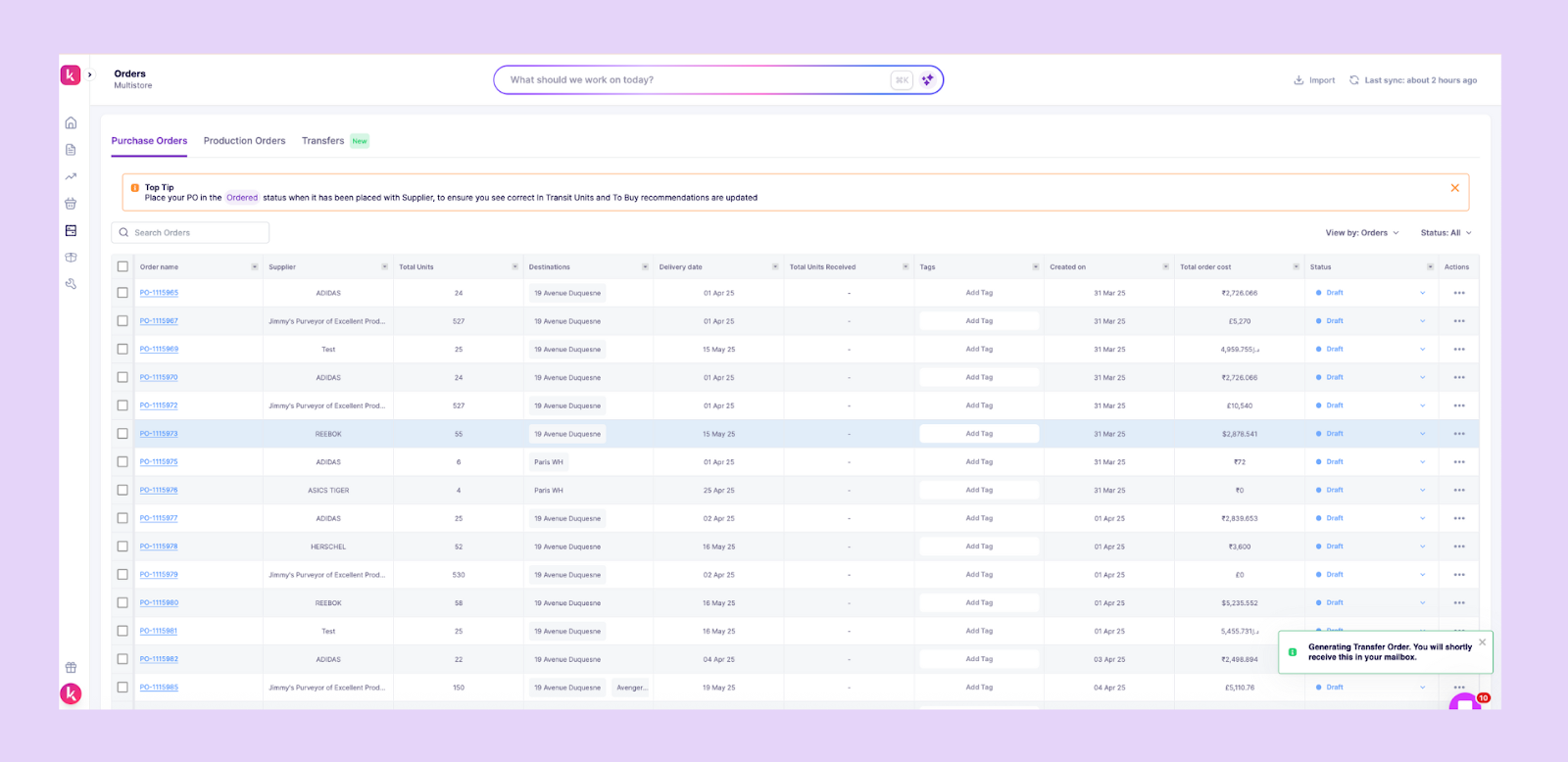
- Scaling without complexity: Prediko handles bundles, multi-warehouse setups, and seasonal spikes, keeping Shopify and Etsy in sync with supply chain integrations to support growth without disruption.

If you sell on Etsy and use Shopify to manage your store, Prediko is a valuable addition to your operations, saving you hours of manual work and helping you avoid costly inventory mistakes.
Sync Shopify and Etsy Without the Hassle
Accurate inventory sync ensures both platforms always reflect the same reality. It prevents overselling, keeps stock properly allocated across bundles, preorders, and warehouses, and removes the guesswork from managing multiple channels.
Prediko adds a layer of intelligence to this sync, handling multi-warehouse, multiple stores, and channel-specific needs while updating stock instantly across both platforms. With Prediko, you have one reliable source of truth for every product, no matter how complex your operations.
Start your 14-day free trial with Prediko today and see how simple multichannel inventory management can be.
Frequently Asked Questions
1. Can you link Shopify and Etsy inventory?
Yes, you can link Shopify and Etsy using third-party apps like CED Commerce. Prediko centralizes both platforms and updates stock in real time whenever an order is placed.
2. How do I sync my Etsy products to Shopify?
You can sync your Etsy products to Shopify using third-party apps. These tools import your Etsy listings into Shopify and keep product details and inventory updated across both platforms.
3. Can I sell the same items on Etsy and Shopify?
Yes, the same products can be listed on both. Prediko ensures there’s no confusion, so that every sale reduces stock correctly, preventing oversells or mismatched counts.
4. How to enable inventory sync on Shopify?
You can enable inventory sync on Shopify by using an integration app that connects Shopify with your other sales channels.
.svg)
.png)






